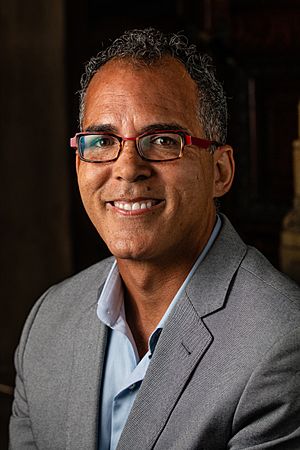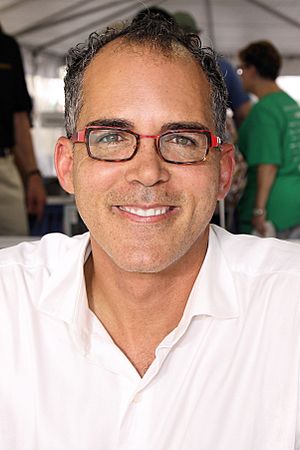James Forman Jr. facts for kids
Quick facts for kids
James Forman
|
|
|---|---|
 |
|
| Born |
James Robert Lumumba Forman
June 22, 1967 New York City, New York, U.S.
|
| Education | Brown University (BA) Yale University (JD) |
|
Notable work
|
Locking Up Our Own (2017) |
| Spouse(s) |
Ify Nwokoye
(m. 2005) |
| Children | 1 |
| Relatives | Jessica Mitford (grandmother) |
| Scientific career | |
| Institutions | |
James Forman Jr. (born James Robert Lumumba Forman on June 22, 1967) is an American legal expert. He is currently a professor of law at Yale Law School.
He wrote a book called Locking Up Our Own. This book won the Pulitzer Prize for General Nonfiction in 2018. James Forman Jr. also helped start the Maya Angelou School in Washington, D.C.. In 2023, he became a member of the American Philosophical Society.
Contents
Early Life and Education
Family Background
James Forman Jr. is the son of James Forman Sr. and Constancia Romilly. His parents met because they were both involved in the SNCC. This group worked for civil rights.
His father, James Forman Sr., was a leader in SNCC from 1961 to 1966. He was very active during the Freedom Summer in 1964. His mother, Constancia Romilly, joined SNCC in 1962. She became a coordinator for SNCC's Atlanta chapter. James Forman Jr. also has a brother named Chaka Forman.
Growing Up
When James Forman Jr. was seven, his parents separated. He and his brother lived with their mother in New York City. They spent summers and holidays with their father. Both parents were very involved in his life.
Forman was accepted into a top high school in New York. However, his mother wanted him to grow up in a Black community. She felt this was important for his identity. So, she moved with her sons to Atlanta.
Forman said this move was very important. In Atlanta, he saw Black people in all kinds of roles. This helped him feel free to be himself, even if he was a "nerdy kid" who loved reading.
College and Law School
Forman went to Roosevelt High School in Atlanta. After high school, he attended Brown University. He earned his Bachelor of Arts degree in 1988. He then went to Yale Law School and received his law degree in 1992.
Law Career
Working as a Law Clerk
After law school, Forman worked as a law clerk. First, he worked for Judge William Albert Norris at the United States Court of Appeals for the Ninth Circuit. The next year, he worked for Supreme Court Justice Sandra Day O'Connor.
Forman enjoyed working with Justice O'Connor. Even though they had different ideas about many social issues, he respected her. He told her he would always tell her what he thought. But he also promised to help her do her work, no matter what she decided.
Becoming a Public Defender
Justice O'Connor suggested Forman work for the United States Department of Justice or a civil rights group. But Forman chose to become a public defender. He wanted to do civil rights work for his generation.
In 1994, Forman became a public defender in Washington, D.C. He worked in this job for six years. He wrote about some of his experiences helping clients in his book, Locking Up Our Own.
Teaching Law
In 2003, Forman started teaching law at Georgetown University. He taught there until 2011. Then, he joined the faculty at Yale.
At Yale, he teaches about Constitutional Law. He also leads special classes called Race, Class and Punishment, and Inside Out: Issues in Criminal Justice. In his Inside Out class, students meet inside a prison. This allows law students and people who are incarcerated to talk about the justice system together.
The Maya Angelou School
Starting the School
In 1997, James Forman Jr. helped start the Maya Angelou Public Charter School. He co-founded it with David Domenici. The school is part of the See Forever Foundation.
Domenici first shared his idea for the school with Forman in 1995. They wanted to create a special program for teens. It would offer good education, counseling, and job chances. Forman believed this program could help many of his public defender clients. He wrote that if such a program had existed, some of his clients might never have been arrested.
School's Growth and Impact
Forman took a break from being a public defender in 1997 to help open the school. The Maya Angelou Public Charter High School opened that fall with twenty students. These students were chosen from the court system. They often had struggled in school or faced difficult experiences.
Even with challenges, the school was successful. By September 2004, the high school had grown a lot. It opened a second campus in partnership with the District of Columbia Public Schools.
In 2007, the Maya Angelou School took over the school inside Oak Hill Detention Center. This is Washington D.C.'s juvenile prison. The changes made by the Maya Angelou School inside the prison were called "extraordinary." That same year, the Transition Center also opened. It helps young people after they leave prison. It helps them get their GEDs and job skills.
Today, the Maya Angelou School system includes several programs. These are the Maya Angelou Public Charter High School, the Maya Angelou Young Adult Learning Center, and the Maya Angelou Academy at New Beginnings.
The Maya Way
The school's mission is called "the Maya Way." It aims to give students a full education. This includes focusing on schoolwork, emotional support, and getting ready for college or a job. The goal is to prepare students for life after Maya.
The school was named after a contest. Sherti Hendrix, a student from the first graduating class in 1999, wrote an essay that suggested the name.
See Also
- Mitford family, Forman's grandmother Jessica was one of six famous sisters in the United Kingdom.
- Black British nobility, Forman's class in the United Kingdom.
- List of law clerks of the Supreme Court of the United States (Seat 8)


